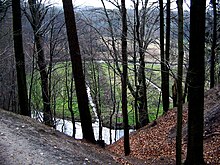This article includes a list of general references, but it lacks sufficient corresponding inline citations .(May 2013) |
Bad Fallingbostel | |
|---|---|
 Saint Dionysius Church | |
Location of Bad Fallingbostel within Heidekreis district  | |
| Coordinates: 52°52′03″N09°41′48″E / 52.86750°N 9.69667°E | |
| Country | Germany |
| State | Lower Saxony |
| District | Heidekreis |
| Government | |
| • Mayor (2021–26) | Rolf Schneider [1] (SPD) |
| Area | |
• Total | 63.15 km2 (24.38 sq mi) |
| Elevation | 67 m (220 ft) |
| Population (2022-12-31) [2] | |
• Total | 12,340 |
| • Density | 200/km2 (510/sq mi) |
| Time zone | UTC+01:00 (CET) |
| • Summer (DST) | UTC+02:00 (CEST) |
| Postal codes | 29683 |
| Dialling codes | 05162, 05163 |
| Vehicle registration | HK |
| Website | www |
Bad Fallingbostel (Northern Low Saxon: Bad Fambossel) is the district town (Kreisstadt) of the Heidekreis district in the German state of Lower Saxony. Since 1976 the town has had a state-recognised Kneipp spa and has held the title of Bad since 2002. It has close ties to Walsrode, a few miles to the west. Until 2015, there was a British Army base in Bad Fallingbostel, It also hosted Defender 2020, the largest US Army/NATO exercise since the Cold War. The town has around 11,000 inhabitants.
Contents
- Geography
- Location
- Sub-divisions
- History
- Demographics
- Religion
- Government
- "Adopted town"
- Town-twinning
- Proposed merger into the town of Böhmetal
- Arts and culture
- Events
- Places of interest
- Infrastructure
- Military installations
- Transport
- Notable people
- People from the town
- People associated with the town
- References
- External links









